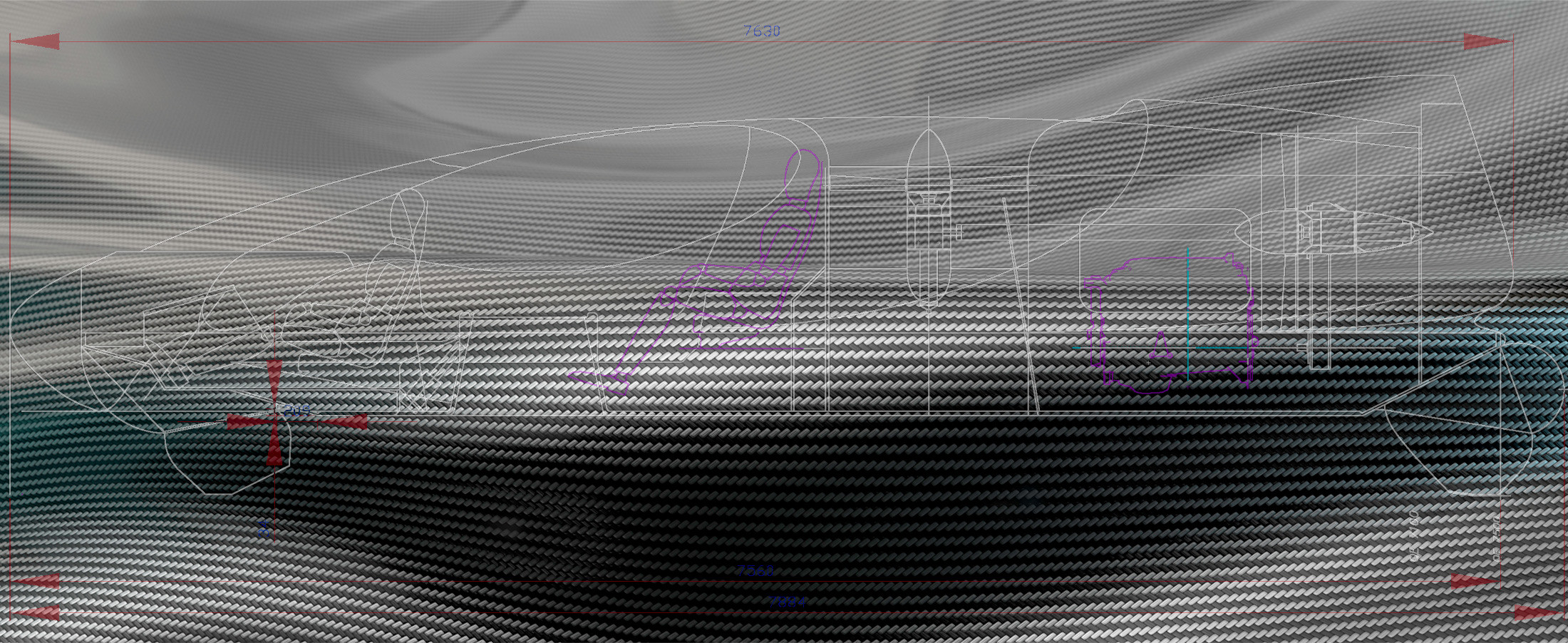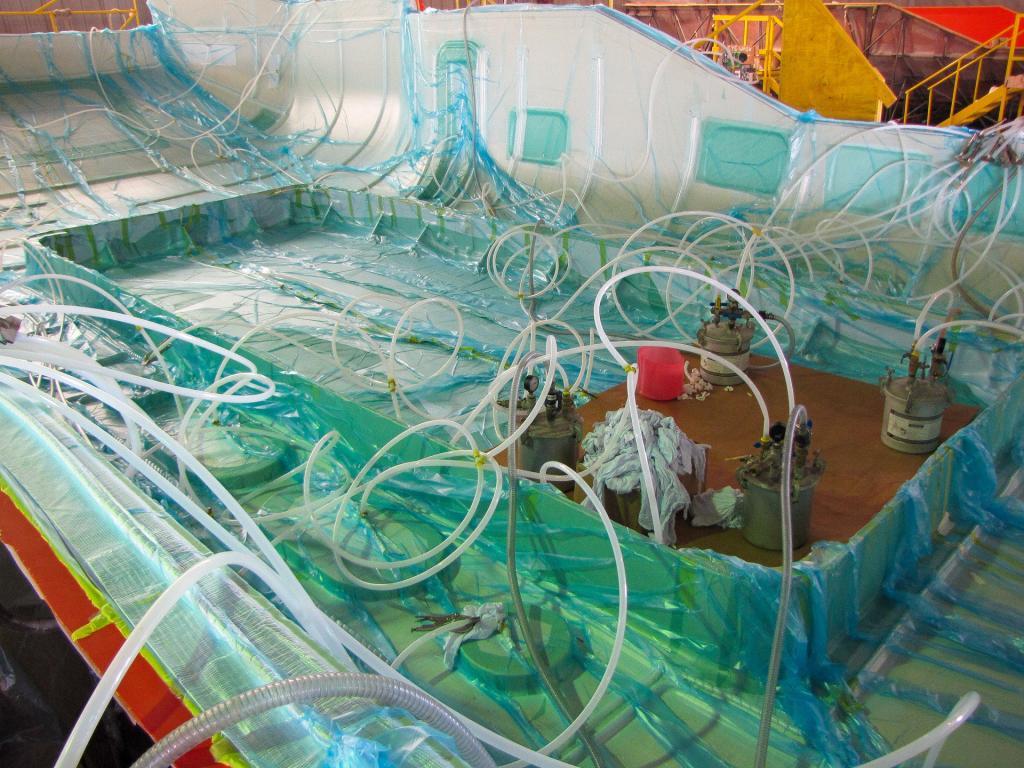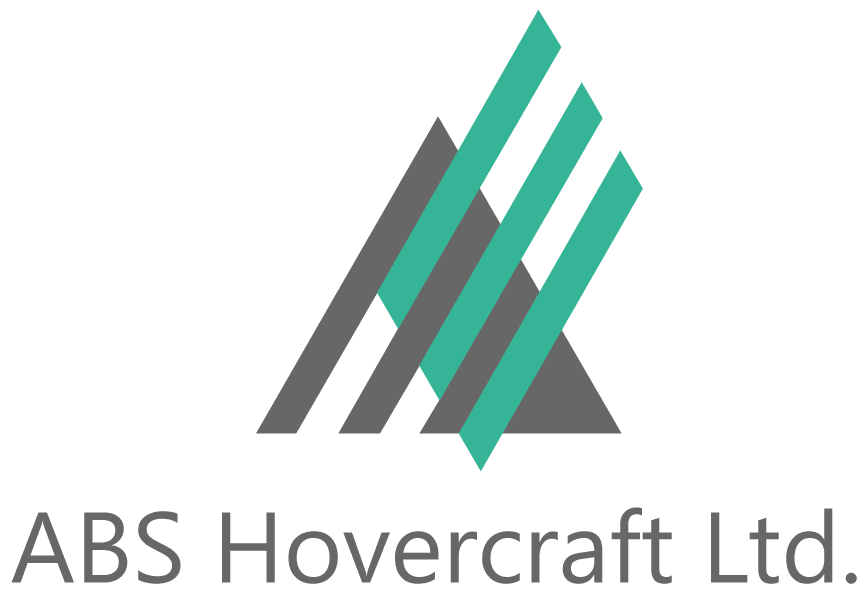
Advanced Composites
Composite materials are often referred to as GRP (Glass Reinforced Plastics) or FRP (Fibre Reinforced Plastics).
Layers of fabric such as glass, kevlar or carbon fibres positioned in a mould are infused with resin and allowed to cure into the required structure. This is known as a laminate. The same method can be used where the laminate is produced on either side of a light weight core material like foam or honeycomb. This is known as a sandwich structure. Fabrics and resins used are available in a broad variety of mixtures, materials, styles and weaves. With composite materials a broad range of products with a huge spectrum of properties can be manufactured.
With vacuum technologies as used in Aircraft and Space technology composite structures can further be weight optimized, with the resulted parts being often referred to as Advanced Composites which is used in the DONAR and ABS M10 Hovercraft.
Where both, highest performance and reliability are required, Advanced Composites are broadly recognised by experts as the material of choice.

weight comparison
advanced composites
A given structure made from advanced composite materials is significantly lighter but more solid and rigid at the same time than a comparable aluminium structure because of its higher tensile strength.
For Hovercraft this translates into a higher power-to-weight ratio (better payload capacity, performance and higher seaworthyness).
aluminium
Aluminium is only available in flat sheets of standard sizes and thickness. It needs to be welded or rivited which results in areas of high stress and structural weaknesses.
In addition, aluminium has a low tensile strength compared with advanced composites. These factors result in aluminium structures being more than 20% heavier than a comparable structure made from advanced composite material.
corrosion
Advanced composites do not suffer from any form of corrosion and so there is no requirement for cleaning or flushing with fresh water. Even in a harsh marine environment there is no need to consider the problems of galvanic corrosion with tools, equipment, electrical wire and cabling or contact with other vessels.
Advanced composites do not suffer under any environmental conditions. They can accommodate high temperature environments and are immune to degradation due to high levels of ultraviolet light and extreme exposure to direct sunlight as found under tropical conditions.
Advanced composites are also best in low temperature environments such as arctic and sub-arctic conditions.
Even marine grade aluminium is subject to corrosion. In a marine environment careful monitoring of aluminium is required for early signs of corrosion. In order to keep structural weight to a minimum, hovercraft typically use thin sheets and so it does not take long for corrosion to have a debilitating effect on the structure. Typical causes of aluminium corrosion are:
- When moored alongside steel-vessels the mooring connection can cause galvanic corrosion (two dissimilar metals touching) that will cause the hovercraft to act as a sacrificial anode.
- Any steel tools and wires inadver- tently left in the bilges will cause galvanic corrosion rapidly attacking the aluminium structure. This is also a problem with any dissimilar metal within metallic equipment fitted to an aluminium vessel.
- Lying water or moisture left in a close, inaccessible chambers will cause corrosion that only becomes obvious after the structure has degredated from the inside.
energy absorption
With the intrinsic flexibility of advanced composite materials combined with the high energy absorbing characteristics of core materials, impacts can be absorbed without damage. Even with a severe impact, damage is likely to remain in a localised area without distorting the surrounding structure.
Aluminium has a low tolerance for absorbing energy. Under impact, hull panels will distort or puncture rather easily with distortion often transferring through into its supporting structure requiring expensive and time-consuming repairs. A severe impact can even distort the whole structure causing misalignment of transmission-systems, machinery and equipment.
design aspects
The homogenous nature of Advanced Composites allows a high degree of design freedom both in the shaping of almost any spherical structure and the ability to optimize its stiffness by adjusting its thickness and weave whereever needed.
Thus a particular structural section may have a graduated thickness over its area to precisely match with the flow of forces and loading conditions. This results in an efficient optimised structure (no useless material) with full factors of safety. Even when additional frames and bulkheads are added, the resulting structure acts as a single piece of material. With no areas of high stress there are no inherent problems with failure due to fatigue caused by vibration etc. In addition, because composites tend to absorb energy better than metals, vibrations and cyclic loading of engines, propellers and other machinery are better absorbed by the structure itself.
Modern 3D solid modelling CAD systems like IBM CATIA the leading software in the aircraft and space industry, are perfectly suited to support this design philoloshy that leads to a high design integrity providing maximum structural performance.
Aluminium is available only in standard sizes. Any single panel must have sufficient thickness to comply with the strength requirements of the most highly loaded part of that panel. Hence there will be excess material thickness greater than needed in the less loaded parts of the panel.
To combat the excess thickness of materials and to ensure the lightest possible structural weight, aluminium hovercraft structures can be designed with thinner materials but with lower factors of safety which would compromise resistance to damage etc. Any construction requires that joints are made and the material is distorted (bent) or welded to conform to the construction requirements.
Bending of material causes localised high stress areas. Welding material not only results in high stress areas but also reduces strength in the welded joint. When subject to vibration and cyclic loading of engines, propellers and other machinery, high stress areas can result in fatigue cracking and failures. Recent experience with aluminium Hovercraft structures confirm, that those drawbacks support the creation of cracks. The US Coast Guards therefore issued a warning on the use of aluminium in Hovercraft structures.
repairability
Advanced composites are ease to repair by semi skilled workers and trained crew. Repair materials may be carried on board and used in the field without any requirements for power or other specialist repair facilities.
Once repaired, the structure again retains its homogenous characteristic and the repaired area is effectively as strong and robust as the initial structure.
Aluminium structures require skilled experts to carry out repairs, merely possible in the field. To repair an aluminium structure, power is required to operate TIG or MIG welding equipment and so if a repair is required on a vessel remote from any power source then a generating set will be required in addition to the specialist welding equipment.
High stress joints due to material bending or welding are susceptible to fatigue cracking and failure. Experience shows that this can occur very early in the vessel service life and will have to be repaired by welding which itself reduces structural strength and creates a high stress area which can lead to further cracking and failure. This vicious circle of failure and repair can drastically reduce the life of any vessel.
comparison noise & vibration
Advanced composite is an energy absorbing material.
Noise vibrations through the structure are absorbed which has a noise reducing effect.
Due to their rigidity and non-energy absorbing nature, aluminium – as other metals – are an effective transmitter of noise. In order to reduce internal noise to an acceptable level, acoustic noise-reducing insulation has to be added. To be affective, acoustic insulation needs to be dense and so will increase vessel weight.
In addition, under tropical conditions these acoustic materials can soak up moisture causing added weight and deterioration of the insulation as well as supporting corrosion to the aluminium.
life-cycle costs
The design and development of structures in advanced composites is expensive. However, with the advantages of composite materials in mind ABS took the strategic decision to invest substantially into the design of the ABS M10.
The benefits in the production process more than compensates the upfront investment over the long run so that competitive prices can be maintained. More significant is the cost-advantage in operating and maintaining a craft in advanced composites which lead to a low level of life cycle costs.
Aluminium is a recognised material when employed in commercial vessels such as passenger ferries where weight considerations have a lower priority and the vessel does not have to withstand the rigours of an amphibious vehicle such as a hovercraft.
With the operational experience of many years of aluminium Hovercraft their disadvantages became obvious to all operators. Besides lower performance their high cost of maintenance – in particular of the structure – result in high and mostly hidden life cycle costs; one reason, why the older generation Hovercraft operating over the English Channel had to be put out of service recently.
In particular the hull needs frequent inspection and survey with an inherent risk of structural failures and cracks in critical areas due to an increased level of vibration. Increased preventive maintenance to keep corrosion under control pays its toll. Repairs are time-consuming and costly.
